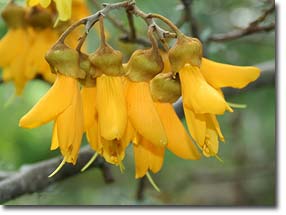Nitrogen Fixing Trees - The Multipurpose Pioneers
Animal Forage, Food Forests, Food Plants - Perennial, Fungi, Plant Systems, Rehabilitation, Soil Biology, Trees — by Craig Elevitch
The myths about the wonders of nitrogen fixing trees are many. Craig Elevitch (see bio at bottom) and Kim Wilkinson explain how to use them effectively.
Nitrogen Fixing Trees for Permaculture
 Flowers of the leguminous tree, Kowhai, the national flower of New Zealand |
Nitrogen fixation is a pattern of nutrient cycling which has successfully been used in perennial agriculture for millennia. This article focuses on legumes, which are nitrogen fixers of particular importance in agriculture. Specifically, three legumes (nitrogen fixing trees, hereafter called NFTs) are especially valuable in subtropical and tropical permaculture. They can be integrated in a permaculture system to restore nutrient cycling and fertility self-reliance.
On unvegetated sites, "pioneer" plants (plants which grow and thrive in harsh, low-fertility conditions) begin the cycling of nutrients by mining and accumulating available nutrients. As more nutrients enter the biological system and vegetative cover is established, conditions for other non-pioneering species become favourable. Pioneers like NFTs tend to benefit other forms of life by boosting fertility and moderating harsh conditions.
Nitrogen fixing trees are often deep rooted, which allows them to gain access to nutrients in subsoil layers. Their constant leaf drop nourishes soil life, which in turn can support more plant life. The extensive root system stabilises soil, while constantly growing and atrophying, adding organic matter to the soil while creating channels for aeration. There are many species of NFTs that can also provide numerous useful products and functions, including food, wind protection, shade, animal fodder, fuel wood, living fence, and timber, in addition to providing nitrogen to the system.
Craig Elevitch is based in Hawaii and has been working for island resource self-sufficiency since 1989. He directs Agroforestry Net, a nonprofit educational organization dedicated to empowering people in agroforestry and ecological resource management. The organization’s internationally recognized publications have guided thousands of readers in becoming more proficient in ecological food production, agroforestry, and permaculture. Craig edits The Overstory, a monthly agroforestry journal with over 8,000 subscribers in 185 countries. His books include Agroforestry Guides for Pacific Islands (2000), The Overstory Book: Cultivating Connections with Trees (2004), and Traditional Trees of Pacific Islands: Their Culture, Environment, and Use (2006), all of which promote diverse agricultural systems that produce abundant food and other resources. Further information and free downloads at Agroforestry.net.

No comments:
Post a Comment